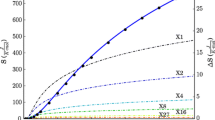Abstract
The local structural response of Ca/Mg substitution and the energetic effects associated with dodecahedral ordering in the pyrope-grossular garnet solid solution are derived from a combination of static lattice energy calculations and Monte Carlo simulations. We start with a thorough analysis of the goodness of the empirical potential models used for the modelling of aluminosilicate garnets. The degree of polyhedral distortion was found to be a sensitive indicator for the quality of the model and, by comparison with experimental data, was used to select the best of several available empirical potentials. The Ca/Mg substitution on the dodecahedral site in garnet was found to produce strong local distortions in the surrounding tetrahedral and octahedral polyhedra. This arises from the absence of rigid unit modes (RUMS) in the garnet structure, because local rotations of otherwise rigid SiO4 tetrahedra and AlO6 octahedra cannot occur in order to accommodate different-sized divalent cations in the dodecahedral sites. Strain effects, therefore, mainly govern the dodecahedral substitution, and the corresponding strain field around a dodecahedral site has a minimum radius of 5 Å. Pyrope-grossular solid solution compositions were modelled using a supercell approach. For several garnet compositions many different configurations representing individual disordered arrangements were relaxed. The resulting energies were analyzed in terms of different-neighbour interactions to determine the parameters of a model Hamiltonian. The corresponding interaction energies were found to be virtually independent of composition. Surprisingly, the nearest-neighbour interaction between edge-sharing dodecahedra is of no particular significance in the garnets. Instead, the strongest interaction is only via the third-nearest neighbours, i.e. dodecahedra that are edge-shared to a common SiO4 tetrahedron. This cannot lead to dodecahedral long-range order in garnets, but can produce significant amounts of short-range order. Monte Carlo simulations were performed on several compositions to determine the macroscopic effects such as NMR-based cluster occupancy, ordering energy and configurational entropy of the short-range ordering process. As expected, the samples tend to random disorder at high temperatures, and at low temperatures it is compositions nearer Py50Gr50 that depart most strongly from random mixing. For example, a maximum reduction of 3.5 J mol−1 K−1 is predicted for Py75Gr25 and ∼10 J mol−1 K−1 for Py50Gr50. A comparison of NMR cluster occupancy with experimental 29Si MAS NMR resonance intensity is partly successful. However, the changes in NMR cluster occupancy are relatively low (∼5%) compared to changes in configurational entropy (∼30%), implying that it might be difficult to estimate exact entropy data from 29Si MAS NMR line intensities.
Similar content being viewed by others
Author information
Authors and Affiliations
Additional information
Received: 13 August 1999 / Revised, accepted: 10 December 1999
Rights and permissions
About this article
Cite this article
Bosenick, A., Dove, M. & Geiger, C. Simulation studies on the pyrope-grossular garnet solid solution. Phys Chem Min 27, 398–418 (2000). https://doi.org/10.1007/s002690000088
Issue Date:
DOI: https://doi.org/10.1007/s002690000088




